Samsung Galaxy S23 Ultra vs. iPhone 14 Pro Max — which camera wins the night?
It's time to crown a winner

Our Samsung Galaxy S23 Ultra vs iPhone 14 Pro Max low-light shootout is here to help you compare how well these camera phones perform at night.
The Samsung Galaxy S23 Ultra and iPhone 14 Pro Max occupy the top two spots on our best camera phones list, meaning either one will produce a fantastic photo more often than not. But our low-light shootout looks to answer a more specific question.
Samsung improved its low-light photography once again with the Galaxy S23 Ultra, which also reaps the benefits of a new 200MP camera, capable of far more detail than rival phones. The iPhone 14 Pro Max also sports a new sensor — this one a 48MP unit — which gives the phone more flexibility, particularly when taking photos in the dark.
But to see which phone does the best job, we've took photos using both handsets in a variety of low-light scenarios. Take a look at them below, along with our analysis, and see if you agree with our eventual winner.
Also, take a look at our overall Galaxy S23 Ultra vs. iPhone 14 Pro Max comparison to find out the best phone overall. Meanwhile, our Galaxy S23 Ultra vs. iPhone 14 Pro Max RAW photography shootout looks at how the camera phones perform in RAW mode.
Samsung Galaxy S23 Ultra vs. iPhone 14 Pro Max low-light shootout: The photos
Our Samsung Galaxy S23 Ultra vs. iPhone 14 Pro Max low-light shootout uses samples we shot at night as well as in other low-light scenarios.
We can immediately see a difference between the Samsung and iPhone with this main camera image of this phone box planter. We've got a far brighter shot from the Galaxy S23 Ultra, while the stronger contrast and richer colors in the iPhone's photo brings more definition that help parts of the image pop, like the outline of the bright red phone box.
Get instant access to breaking news, the hottest reviews, great deals and helpful tips.
The greater detail in the iPhone 14 Pro Max shot carries it to the victory here.
Moving to the ultrawide camera and the front of a church, there's not much difference between these two images on color. The darker parts of the image — like the bottom of the door and the top of the building — do show up better in the Galaxy S23 Ultra's image. However, you get more details from the bricks in the iPhone's shot, which is a bit more evocative. This is another case where the Galaxy S23 Ultra favors brightness over detail.
Let's take a break from the rear camera shots to compare some selfies. The iPhone's done a lot of work to make my skin look a more "natural" color, unlike the Galaxy which has left the blue-ish tinge of the surrounding lights virtually untouched.
While the iPhone 14 Pro Max's coloring is more appealing, it's much noisier too, which is something the Samsung's night mode addresses quite well. My hair and beard look sharper through the Samsung S23 Ultra.
Going back to the main cameras, we have a telephoto shot of some modern church bells. The iPhone and Galaxy shots are similar in color again, but the iPhone can't draw out the details of the darker parts of the image, like the shadows beneath the bells or the building in the foreground, in the same way. Samsung's shot is dimmer, but the warmer color tone works better here.
For a final round, we'll try a moon shot. This is an easy win for the Samsung, which with a higher maximum zoom and specific algorithms, gives us a fuzzy but still clear shot of the moon.
The iPhone can't figure out how to take this image, meaning after dozens of attempts, the best I could get was a bright disk in the night sky. Apple would be well advised to follow Samsung's lead and add astro photography features to its phones.
Samsung Galaxy S23 Ultra vs. iPhone 14 Pro Max low-light shootout: Which phone wins?
After looking again at all these comparisons, I think the Galaxy S23 Ultra produces better night shots overall. Being able to get the details from the darkest parts of an image is an important ability when you're trying to take photos in low-light; being able to take passable moon photos from a pocketable camera is another impressive benefit.
The only thing I will say in the iPhone's favor is that its processing, while more visibly aggressive, can help in certain situations. Bringing out the outlines of a subject, boosting particular colors or altering the coloration of a selfie to make it look like a more typical photos are some of the possible edits you'd want to make before sharing or using a photo, but that the iPhone effectively applies those changes automatically. Anyone wanting to make changes like that to the Galaxy S23 Ultra's photos would have to apply it themselves.
There's a reason we consider the Galaxy S23 Ultra to be the better camera phone, and the device's low light performance is one of the big reasons why.

Richard is based in London, covering news, reviews and how-tos for phones, tablets, gaming, and whatever else people need advice on. Following on from his MA in Magazine Journalism at the University of Sheffield, he's also written for WIRED U.K., The Register and Creative Bloq. When not at work, he's likely thinking about how to brew the perfect cup of specialty coffee.
